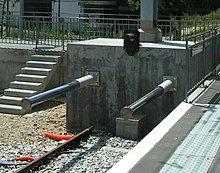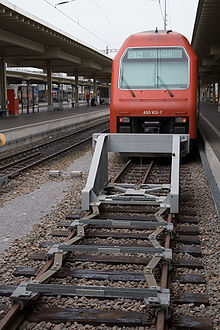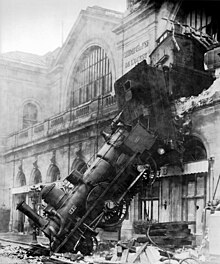Buffer stop: Difference between revisions
No edit summary |
→See also: Removed item from incorrect section |
||
| Line 63: | Line 63: | ||
== See also == |
== See also == |
||
31 January 2013, train failed to stop at the end of the line in Cleveland, Qld australa. Overshot buffer stop and into station building |
|||
* [[List of rail accidents]] |
* [[List of rail accidents]] |
||
Revision as of 14:25, 26 April 2013




A buffer stop or bumper (US) is a device to prevent railway vehicles from going past the end of a physical section of track.
The design of the buffer stop is dependent in part upon the kind of couplings that the railway uses, since the coupling gear is the first part of the vehicle that the buffer stop touches. The term "buffer stop" is itself of British origin, railways in Great Britain principally using buffer-and-screw couplings between vehicles.
Types
Several different types of buffer stop have been developed. They differ depending on the type of coupler used and on the intended application.
- Buffer stops with anticlimbers. These are particularly important for passenger railway applications, because the anticlimbers prevent telescoping of the railroad cars during a head-on impact.
- Buffer stops for a knuckle coupler or an SA3 coupler (centrally positioned between the two rails)
- Buffer stops with traditional "buffers" on either side
- Hydraulic buffer stops
- Friction buffer stops (bolted down to the rail)
If there is extra room behind the bumper block, there is usually a sand or ballast drag that is designed to further retard a runaway train. One such accident occurred when a Northern Line train powered past the bumper block at Moorgate station in 1975 on the London Underground system.
Energy-absorbing
Due to its mass, a train transfers an enormous amount of kinetic energy in a collision with a buffer stop. Rigid buffers can only safely cope with very low-speed impacts (i.e., nearly stationary). To improve stopping performance, a way of dissipating this energy is needed, through compression or friction. Following a buffer stop accident at Frankfurt-am-Main in 1902, the Rawie company developed a large range of energy-absorbing buffer stops. Similar hydraulic buffer stops were developed by Ransomes & Rapier in the UK.
Dowty retarders
When it is desired to slow or stop moving trains, without erecting a solid buffer stop, dowty retarders may be employed. They press upwards against the wheels, and may optionally be turned off as required.
Examples
- Raja Trains Depot in Tehran
- Stopping speed: 20 km/h (12 mph)
- Stopping distance: 20 m (66 ft).[1]
Wheel stop
Wheel stops are used to stop slow moving trains from continuing down a level track section.
Accidents

- 22 October 1895 – Gare Montparnasse, Paris, France – express train overruns buffer stop and falls into street below.
- 4 April 1901 – at the Top Points of the Lithgow Zig Zag, a train lost control on the 1 in 42 (2.381 %) gradient and failed to stop at the buffer stops, coming to rest overhanging Ida Falls Gully, with an immediate 200 ft (61 m) drop in front of the engine.
- 1902 – Frankfurt am Main, Germany – Serious buffer stop collision inspires development of Rawie range of energy-absorbing buffer stops.
- 27 July 1903 – Glasgow St Enoch – 16 killed 27 injured
- 1948 – diesel train through buffer stops at Los Angeles.[citation needed]
- 15 January 1953 – Union Station, Washington, D.C. – Federal Express #173, pulled by PRR 4876, overruns the buffer stop after its brakes fail. The locomotive stops in the concourse before falling through the floor. A temporary floor was built over it for the upcoming inauguration of Dwight D. Eisenhower before it was shipped back to Altoona, Pennsylvania in three pieces for repairs.
- 1972 – BART train went through buffer stops due to fault in automatic train operation.
- 28 February 1975 – Moorgate Underground rail crash – 43 killed, 74 injured – buffer stop collision made far worse by small size "tube" train running into large dimensioned dead end tunnel beyond. The tunnel could accommodate full size surface stock thus permitting the smaller train to concertina inside the tunnel.
- 13 April 1978 – Budapest, Hungary – commuter train overruns a buffer stop owing to brake failure and crashes into the station building. 16 killed, 25 injured.[2]
- 8 November 1986 – Hua Lamphong, Bangkok, Thailand – 5 killed, 7 injured – buffer stop collision made by an unmanned train at a speed of 50 km/h (31 mph).
- 8 January 1991 – Cannon Street station rail crash, London – 2 killed, 200+ injured – commuter train hits buffer stops.
- 11 July 1995 – Largs – BR Class 318 EMU goes through buffer stops.
- 24 July 2001 – ScotRail commuter train hits the buffers as it pulls into Edinburgh Waverley injuring seven people.
- 26 October 2006 – Kuala Lumpur, Malaysia – a Star LRT train goes through buffer stops at the end of a stabling area (turnback perhaps) and ends up dangling over street. The train appears to have been empty of passengers.[3]
- 21 December 2009 – Zagreb, Croatia – commuter train number 5100 from Sisak Caprag crashed into the platform bumper. The cause was antifreeze fluid in the locomotive's braking system which had frozen due to the extremely low outside temperature (−22 °C or −7.6 °F). Luckily, the speed of the train was only between 15 and 20 km/h (9.3 and 12.4 mph). 60 people from the train (including train's engineer) were injured, 7 of them seriously. There were no injuries among people on the platform. The engineer leaned out of the cab window to warn people on the platform that his brakes had failed and that the train would crash at the end of the platform.[4]
- 25 July 2010 – Stavoren railway station, the Netherlands – A maintenance train collided with a buffer stop at the single-track terminus station. The train rammed a small shop, passed through it and stopped at the square behind it. Only two people were injured, out of four people on the train. The accident happened late at night, when passenger services had already finished. The cause is being investigated.[5]
- 2 March 2011 – San Francisco 4th and King Street Station, San Francisco, California – A Caltrain commuter train failed to stop before hitting the buffer stop. Multiple minor injuries were reported.[6]
- 8 May 2011 – Hoboken Terminal, New Jersey – A Port Authority Trans-Hudson rapid transit train crashes into a bumper.[7][8] At least 34 are injured, none critically. The cause is being investigated.
- 22 February 2012 – Buenos Aires, Argentina – a commuter train collided with buffer stops at a train station in Buenos Area during the morning rush hour. The accident killed 51 people and injured more than 700 in Argentina's worst rail accident in 30 years.[9] The buffer stops do not absorb energy.
- 15 January 2013 – Saltsjöbaden, Sweden – A cleaning lady accidentally set a four-car EMU commuter train in motion while cleaning it at the Neglinge depot. It reached 80 km/h and demolished a buffer stop at Saltsjöbaden station before crashing into a small apartment block about 25 m beyond the end of the track, badly injuring the cleaning lady.[10]
- 15 April 2013 - Wellington, New Zealand - A Matangi EMU fails to stop at the Melling railway station and collides with the buffer stop. No injuries reported. [11]
See also
References
- ^ "Infrastructure (Iran)". Railway Gazette International. 1/2009: 16. 2009.
{{cite journal}}: Unknown parameter|month=ignored (help) - ^ "A Csepeli Hév fekete áprilisa – 33 éve történt a tragikus HÉV baleset". Retrieved 11 November 2012.
- ^ Chow, Vincent. "Derailment of Malaysia LRT". Vincent Chow dot Net. Retrieved 14 December 2011.
- ^ http://www.jutarnji.hr/vlak-na-kolodvoru-udario-u--odbojnik--vise-od-50-ozlijedenih-/418298/
- ^ "Two hurt as maintenance train ploughs through shop". DutchNews.nl. 26 July 2010. Retrieved 14 December 2011.
- ^ Keeling, Brock (2 March 2011). "Accident at 4th & King Caltrain Station Sends Passengers to Hospital". sfist.com. Retrieved 14 December 2011.
- ^ Fenton, Reuven (8 May 2011). "Dozens hurt after PATH train crashes into Hoboken platform". New York Post. Retrieved 14 December 2011.
- ^ Cowan, Alison Leigh (8 May 2011). "Dozens Injured as Train Crashes in New Jersey". The New York Times. Retrieved 14 December 2011.
- ^ "Argentine train crash kills 49 people, hurts 600". Yahoo.com. 22 February 2012. Retrieved 22 February 2012.
- ^ "Stockholm train crashed into apartments 'by cleaner'". BBC News. January 15, 2013.
- ^ "Passengers 'jolted' after train collision". Fairfax NZ. April 15, 2013.
